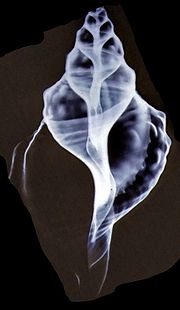
Columella (mollusk)
Encyclopedia

Snail
Snail is a common name applied to most of the members of the molluscan class Gastropoda that have coiled shells in the adult stage. When the word is used in its most general sense, it includes sea snails, land snails and freshwater snails. The word snail without any qualifier is however more often...
shell, a gastropod shell
Gastropod shell
The gastropod shell is a shell which is part of the body of a gastropod or snail, one kind of mollusc. The gastropod shell is an external skeleton or exoskeleton, which serves not only for muscle attachment, but also for protection from predators and from mechanical damage...
. The columella is often only clearly visible as a structure when the shell is broken, or sliced in half vertically, or viewed as an X-ray
X-ray
X-radiation is a form of electromagnetic radiation. X-rays have a wavelength in the range of 0.01 to 10 nanometers, corresponding to frequencies in the range 30 petahertz to 30 exahertz and energies in the range 120 eV to 120 keV. They are shorter in wavelength than UV rays and longer than gamma...
image.
The columella runs from the apex of the shell to the midpoint of the undersurface of the shell, or the tip of the siphonal canal
Siphonal canal
Some sea marine gastropods have a soft tubular anterior extension of the mantle called a siphon through which water is drawn into the mantle cavity and over the gill and which serves as a chemoreceptor to locate food. In many carnivorous snails, where the siphon is particularly long, the structure...
in those shells which have a siphonal canal. If you visualize a snail shell as a cone of shelly material which is wrapped around a central axis, then the columella more or less coincides spatially with the central axis of the shell. In the case of shells that have an umbilicus, the columella is a hollow structure.
The columella of certain gastropod shells can have an impressive variety of plications or folds (the columellar fold, plaits or plicae), which are usually visible when looking to the inner lip into the aperture of the shell. These fold can be wide or narrow, prominent or subtle. These features of the columella are often useful in identifying the family
Family (biology)
In biological classification, family is* a taxonomic rank. Other well-known ranks are life, domain, kingdom, phylum, class, order, genus, and species, with family fitting between order and genus. As for the other well-known ranks, there is the option of an immediately lower rank, indicated by the...
, genus
Genus
In biology, a genus is a low-level taxonomic rank used in the biological classification of living and fossil organisms, which is an example of definition by genus and differentia...
, or species
Species
In biology, a species is one of the basic units of biological classification and a taxonomic rank. A species is often defined as a group of organisms capable of interbreeding and producing fertile offspring. While in many cases this definition is adequate, more precise or differing measures are...
of the gastropod.
The surface of the columella is called the columellar wall. The columellar callus is a smooth, calcareous thickening, secreted by the mantle
Mantle (mollusc)
The mantle is a significant part of the anatomy of molluscs: it is the dorsal body wall which covers the visceral mass and usually protrudes in the form of flaps well beyond the visceral mass itself.In many, but by no means all, species of molluscs, the epidermis of the mantle secretes...
, extending over the columellar area. The columellar lip is the lower part of the inner lip and is the visible part of the columella and is situated near the axis of coiling. A columellar tooth is a raised projection on the inner lip of a columella in the direction of the aperture
Aperture (mollusc)
The aperture is an opening in certain kinds of mollusc shells: it is the main opening of the shell, where part of the body of the animal emerges for locomotion, feeding, etc....
.
Columellar muscles
The soft parts of the body of the gastropod are held in place in the shell by the columellar muscles. These muscles are attached strongly to the columella itself not just far up in the apex of the shell but also by a long and narrow attachment over the length of a full whorl along the columella.The columellar muscle passes underneath the mantle, greatly thickening the body wall, through the foot and is attached at its other end to inner face of the operculum (if present).
The columellar muscles are contracted when the animal needs to withdraw the foot, head, and other soft parts into the shell for protection from drying out, and from predators. During these contractions the operculum and shell are approximated, and the animal is withdrawn within the latter. . The columellar muscles are equally used to bring the soft body out of the shell. During protraction and retraction, the muscle twists, shortens or elongates.
In very large gastropods such as the Queen Conch, Eustrombus gigas
Strombus gigas
Lobatus gigas, commonly known as the queen conch, is a species of large edible sea snail, a marine gastropod mollusk in the family of true conchs, the Strombidae...
, once the columellar muscles are cut with a knife, the soft parts of the animal fall out of the shell easily. Conch fishermen in the Caribbean Sea
Caribbean Sea
The Caribbean Sea is a sea of the Atlantic Ocean located in the tropics of the Western hemisphere. It is bounded by Mexico and Central America to the west and southwest, to the north by the Greater Antilles, and to the east by the Lesser Antilles....
break a small hole in the spire of the shell, cut the columellar muscles, and harvest the live meat of this species. Often the fishermen dump the empty shell back into the sea again.

